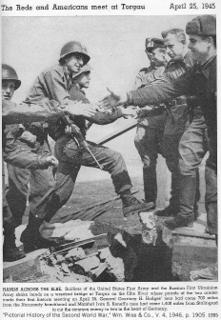Oh, and another thing

I've thought of one more thing that I intended to mention during the unit 2.1 discussions but I forgot to do so. Last one, I promise.
You will recall that we didnt spend a lot of time in discussion over the military aspects of the endings of WW2. However, in your own research, one or two of you may have stumbled across the above famously staged image of US and Soviet troops meeting at Torgau and signifying the end of the war in Europe. The significance of the event that the image portrays is clear to all, indeed, the caption tells how, on April 25, 1945 American troops from Ninth Army and the Soviet 1st Ukrainian Front famously joined hands at Torgau on the Elbe. The American's had fought for 700 miles from Normandy and the Soviet's 1400 from Stalingrad. Impressive stuff. However, what I found facinating in the detail of the image were clues of the relative methods employed in how they achieved such a feat. Despite armies of the 20th century enjoying the relative benifits of industrialised warfare, indeed, for the first time since it occurred to man what great sport there was in fighting each other, we were apparently enjoying conditions where the quantity of ammunition transported into combat outweighed the quantity of fuel (ie, food, forage and water. (Interesting how we appear to be going full circle on this now with fewer, more accurate munitions and a greater demand for fuel, particularly from the resource heavy airmobile element)). Anyway, I digress. My point is the product of a simple observation, where the americans where enjoying the benefit of the Wilys Jeep to get them around and the German's were losing despite the benefit of their Maybach staff cars, judging by the spurs that the young soviet soldier at the rear of the picture is wearing, he arrived there on horseback. 1400 miles. In combat. That's a long way by anyone's standards.


0 Comments:
Post a Comment
<< Home